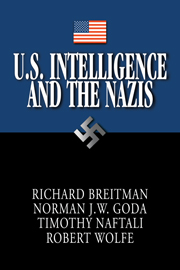Book contents
- Frontmatter
- Contents
- PREFACE
- Map 1
- Map 2
- U.S. INTELLIGENCE AND THE NAZIS
- INTRODUCTION
- SECTION ONE ESPIONAGE AND GENOCIDE
- 1 OSS Knowledge of the Holocaust
- 2 Other Responses to the Holocaust
- 3 Case Studies of Genocide
- 4 Nazi Espionage: The Abwehr and SD Foreign Intelligence
- 5 Follow the Money
- 6 The Gestapo
- SECTION TWO COLLABORATION AND COLLABORATORS
- SECTION THREE POSTWAR INTELLIGENCE USE OF WAR CRIMINALS
- CONCLUSION
- APPENDIX: Western Communications Intelligence Systems and the Holocaust
- TERMS AND ACRONYMS
- SELECTED BIBLIOGRAPHY
- RECORD GROUPS CITED
- CONTRIBUTORS
- INDEX
4 - Nazi Espionage: The Abwehr and SD Foreign Intelligence
Published online by Cambridge University Press: 25 February 2010
- Frontmatter
- Contents
- PREFACE
- Map 1
- Map 2
- U.S. INTELLIGENCE AND THE NAZIS
- INTRODUCTION
- SECTION ONE ESPIONAGE AND GENOCIDE
- 1 OSS Knowledge of the Holocaust
- 2 Other Responses to the Holocaust
- 3 Case Studies of Genocide
- 4 Nazi Espionage: The Abwehr and SD Foreign Intelligence
- 5 Follow the Money
- 6 The Gestapo
- SECTION TWO COLLABORATION AND COLLABORATORS
- SECTION THREE POSTWAR INTELLIGENCE USE OF WAR CRIMINALS
- CONCLUSION
- APPENDIX: Western Communications Intelligence Systems and the Holocaust
- TERMS AND ACRONYMS
- SELECTED BIBLIOGRAPHY
- RECORD GROUPS CITED
- CONTRIBUTORS
- INDEX
Summary
During the war, the Allies viewed German intelligence as a military and political weapon that they could neutralize if they knew enough about it. At the end of the war, Nazi spies, saboteurs, and intelligence officials might have helped diehard Nazis resist the Allied occupation of Germany or prepare for a future struggle, so even in the postwar period the Allies tried to capture German intelligence personnel and to understand the structure of German intelligence organizations. British and American intelligence officials, often working together, were able to fill gaps in their knowledge.
The IWG declassified a small quantity of new Allied material about small German intelligence organizations, such as the Research Office (Forschungsamt), an interception, wiretapping, and decoding service under the nominal supervision of Hermann Goring. The Research Office monitored some of the most sensitive internal Nazi operations, wiretapping uncooperative Catholic priests and Protestant pastors who were or were going to be persecuted. Foreign diplomats in Berlin were another regular target for wiretaps. British and American intelligence paid greater attention to the Abwehr, SD Foreign Intelligence, and the Gestapo.
The Abwehr
Allied officials initially thought of the Abwehr as the premier German intelligence service. The Abwehr was a top-heavy and generally inefficient military intelligence organization of more than twenty-one thousand officials in 1941, not including informants and other sources. Two particularly good studies of the Abwehr have enriched our understanding of this organization, but both of them were written decades ago.
- Type
- Chapter
- Information
- U.S. Intelligence and the Nazis , pp. 93 - 120Publisher: Cambridge University PressPrint publication year: 2005

